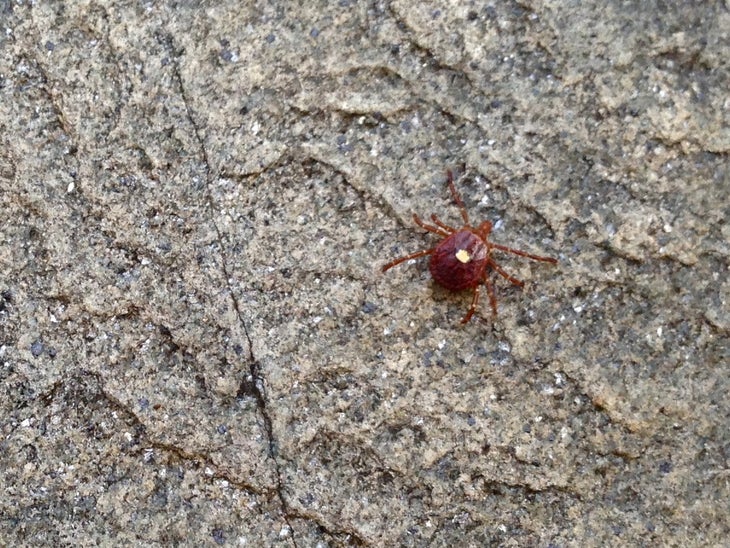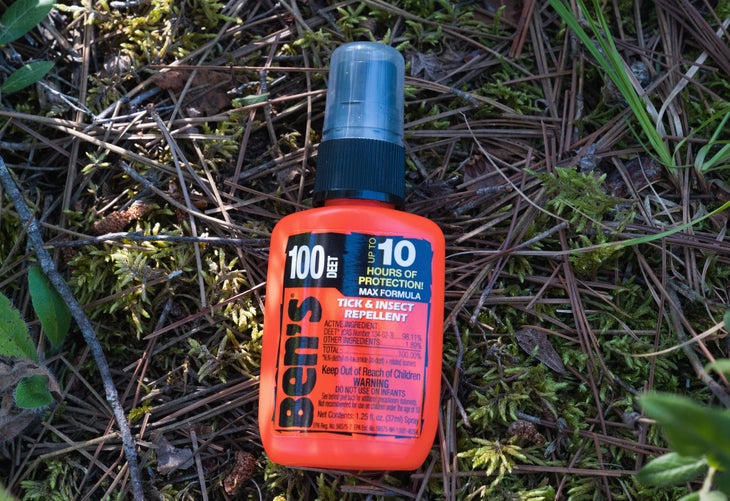Heading out the door? Read this article on the new Outside+ app available now on iOS devices for members! Download the app.
It starts with a bump that wasn’t there before: a tiny, hard, raised dot that you spot or feel with your fingers. When you look closer, you see a small, buried head, a fat thorax, and eight little legs. It’s not a mole or a speck of dirt: It’s a tick.
Ticks are the bane of warm-weather hikers. The tiny bugs are like heat-seeking missiles, latching on to any warm-blooded creature they can reach and sucking its blood for sustenance. Besides being gross and inconvenient, they can transmit a variety of diseases like Lyme disease and Rocky Mountain Spotted Fever, some of which can have serious, long-term effects.
But you don’t need to go out unprotected and just hope for the best: From skillful evasion tactics to heavy-duty bug repellent, you have an arsenal that you can deploy against these parasites. Here’s when you should worry about ticks and how to dispatch them with a little help from our experts.
What are ticks?
It sounds like a simple question, but believe it or not, you likely don’t know the answer. For starters: Ticks aren’t insects. They’re actually arachnids, eight-legged critters in the same class as spiders. While there are a number of different families of ticks, they’re all equipped with a built-in infrared camera of sorts: They’re all capable of seeing body heat as infrared light. That allows them to quickly zero in on potential hosts. Once they’ve latched on, their normally tiny bodies can expand to several times their initial size as they fill up with blood.
Another thing to know about ticks is that they’re very, very hardy. The ticks we’re used to in the U.S. have a tough exoskeleton that renders them resistant to being squished or ripped apart. They can survive for months without food or water, hiding in humid spots to avoid desiccation. They can even survive in near-vacuum for a limited period of time.
What kind of ticks are there in the United States?

According to the Centers for Disease Control and Prevention, there are seven different types of ticks to be concerned about in the United States: American dog ticks, blacklegged ticks (also known as deer ticks or hard-bodied ticks), brown dog ticks, Gulf Coast ticks, lone star ticks, Rocky Mountain wood ticks, and western blacklegged ticks. While each species has a different range, in general, the further south and east you go, the more varieties you’ll have to deal with.
What diseases can ticks spread?
Ticks can spread a variety of diseases, ranging from serious and sometimes fatal ones to relatively benign illnesses.
The most well-known and common tickborne illness is Lyme disease. Named after one of the towns in Connecticut where researchers first described it, Lyme is caused by tick-spread bacteria, and often begins with a rash followed by a variety of symptoms ranging from joint pain and weakness to memory problems and heart palpitations. Treatment usually involves a few weeks of antibiotics.
A much rarer tickborne disease is Rocky Mountain spotted fever, caused by a different bacterium, Rickettsia rickettsii, spread by several kinds of ticks. Symptoms include a rash of bleeding spots on the skin, as well as fever, nausea, and vomiting. While most patients make a full recovery after treatment with antibiotics, some rare cases lose digits or parts of their limbs to gangrene; a few die.
Other diseases spread by ticks in the United States include tularemia, ehrlichiosis, and anaplasmosis. Generally, if you find a tick on your body, it’s best to get checked out by a doctor right away, even if you don’t have any symptoms.
How can I avoid tick bites?

No one likes plucking a tick out of their skin, so prevention is the best way to deal with the little jerks. One of the best ways to avoid ticks is to wear long pants and sleeves whenever you’re traveling through heavily forested areas, tall grass, or brush. A set of lightweight long pants and shirt for hot days is a good investment. Treating your clothing with permethrin, or buying clothes already pretreated with it, will stop ticks from hitching a ride and biting you later (permethrin kills ticks on contact).
Second, use bug spray on your skin. Go for a formulation using DEET or picaridin, both of which have been extensively tested and shown to be safe and effective. Avoid plant-based or “natural” repellents; at best, they fend off some ticks, but aren’t nearly as effective as the two we mention above. Pay special attention to your ankles and calves: Ticks hiding in the grass often latch on low.
When you get home, don’t just throw your clothes on the floor: On the off-chance a tick found a safe spot to hide in your treated clothes, it could emerge and bite you later. Instead, toss them right in the wash. Do a thorough tick check after you strip. (Enlist a friend to check your back, or use a mirror.) Don’t neglect nooks and crannies—like your armpits, neck, and groin—which are especially good hiding places.
What’s the best way to remove ticks?
At some point, you likely learned to remove ticks by holding a flame to their backside. The thinking goes that it’s safer to make them burrow out on their own instead of pulling them out, because you risk yanking off their head. But according to researchers, that actually increases your risk of infection as it encourages the tick to regurgitate saliva back into you (gross). A 1996 study conducted in Spain found that people who crushed or burned a tick embedded in them were more likely to suffer Lyme disease than those who just pulled it out. Here’s the proper method:
- Using a pair of fine tweezers, grasp the tick as close to your skin as possible.
- Pull the tick straight out, without twisting or jerking it. It should come out whole; if any parts remain in your skin, pull them out with the tweezers if possible. Clean the area with a disinfectant.
- Destroy the tick by tossing it in your campfire, cutting it in half with a pocket knife, or, if at home, flushing it down your toilet.
After you’ve discovered a tick, remove it right away: The longer you leave it attached to you, the greater your risk of catching a tickborne illness. Leaving a tick on you for more than 24 hours results in a higher risk of contracting Lyme disease.
What do dog owners need to know about ticks?
Since dogs don’t know how to do a tick check—and don’t have the opposable thumbs to pull them out—your pooch is a veritable buffet for bloodthirsty parasites. That goes double if you hike with your dog off-leash, where they can crash through brush and high grass.
If you take your dog hiking, the best way to avoid ticks is to keep them on trail. Also make sure they’re treated with flea-and-tick medication, and that you don’t miss their scheduled doses. Check them after each hike, paying special attention to the insides of their ears, under their collars, and the skin folds between their legs, which are all prime places for ticks to hide.
Does Lyme disease have a cure?
Lyme disease is one of the most common and potentially debilitating tickborne illnesses in the U.S. Currently there’s no cure, but scientists and pharmaceutical companies are currently testing two potential vaccines for use in humans. Drug testing in the U.S. is famously slow, so these likely won’t be available for another two to five years. Ditto for oral preventative drugs. Though chewable anti-tick medications are currently available for veterinary use, the FDA has yet to approve them for humans. That said, some of the ingredients in your dog’s tick pills could show up in human meds in the next few years. So, if you spend a lot of time in tick-infested areas, keep an eye out for updates.
From 2024
